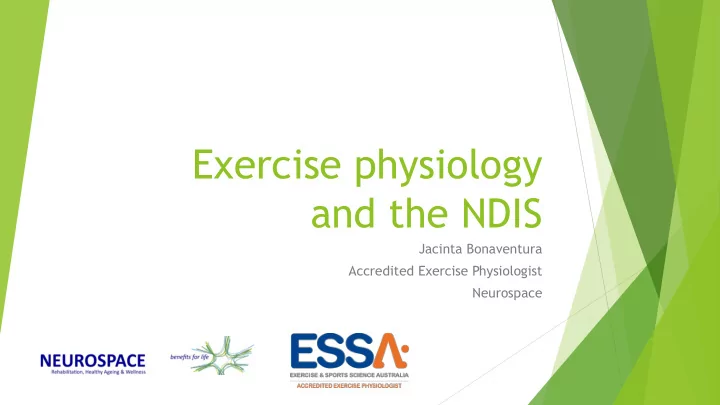

Exercise physiology and the NDIS Jacinta Bonaventura Accredited Exercise Physiologist Neurospace
What has the NDIS meant for EP? Access to funding Increase in clients where we can have a huge impact Long term management where exercise is a possibility vs Short term rehab where hands on approach is prioritised Multidisciplinary team EPs included Support workers and allied health assistants Increase awareness and education of the profession
How does an EP use NDIS funding? Intensive burst of therapy Community integration – public gym, work gym or hydrotherapy Home Exercise programs Training of family and support workers Exercise equipment prescription
What are the challenges of EP and NDIS? Difference between exercise physiology (EP) and physiotherapy (PT) Physiotherapist is… university qualified to assess, diagnose, treat and prevent a wide range of health conditions and movement disorders. Physio under Improved Daily Living code at $175.47 per hour Exercise physiologist is… university qualified to design, deliver and evaluate safe and effective exercise interventions for people with acute, sub-acute or chronic medical conditions, injuries or disabilities. EP under the Health and Wellbeing code at $145.63 per hour NDIS planners are typically unaware of the differences
What are the challenges of EP and NDIS? Difference between exercise physiology (EP) and personal training Exercise Physiologists Personal Trainers 4 Year University Degree qualified Certificate 4 may be completed in and accredited with ESSA. less than 6 weeks of training. Members of the health/medical Members of the sport and recreation sector with Medicare Provider sector. numbers Work with persons at risk of Work with persons of low risk only developing, or with existing chronic (i.e. “apparently healthy and complex medical conditions and populations”) injuries (i.e. ‘specific populations’)
When should you request EP funding? Progressive neurological conditions – MS, PD, MND Stroke, traumatic or acquired brain injury Spinal cord injury Mental health – PTSD, Depression Pain management, fibromyalgia, arthritis/RA Autism, Aspergers, Developmental delay Chronic fatigue syndrome What exercise is safe to do? Exercise is medicine
What are the challenges of EP and NDIS? Gym memberships are not considered reasonable and necessary People come with goals relating to health and wellbeing but no EP funding Increased unpaid administration/report writing time
Case studies What is possible under NDIS Mr D – working (economic participation) Ms S – train carers in hydro + gym program Mr L – MTD speech and EP
Recommend
More recommend